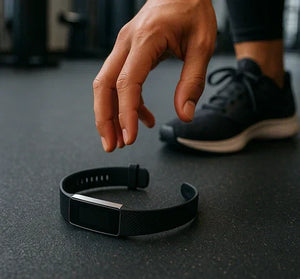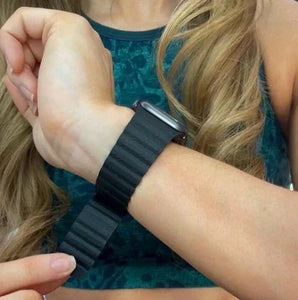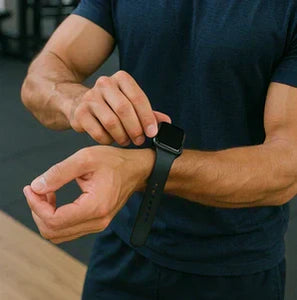We wear our Apple Watches absolutely everywhere, at the gym, in work meetings, even in bed. It feels harmless, right? But here’s the twist in the tale: the strap hugging your wrist all day might not be as clean as it looks. Some Apple Watch bands could contain PFAS, those “forever chemicals” linked to health risks. Not the kind of thing you want soaking into your skin 24/7. Do not panic, though. We are here to break down which straps are safer and what Apple is actually doing about it, so you can avoid getting caught up in the chemical mess. We aim to keep this simple and useful, because your wrist deserves much better than mystery materials.

When Comfort Meets Chemistry: Why this Matters
Here at Fitstraps, we love comfort. Soft, flexible straps that do not itch or give you that annoying watch strap rash on your wrist. That is what makes the Apple Watch feel like a second skin. But here’s the catch, though, comfort can sometimes hide chemistry. The materials that make straps smooth and waterproof often rely on synthetic coatings and treatments. Some of those can include PFAS, the so-called “forever chemicals” we mentioned that never break down and can build up in our bodies over time.
You’ve probably seen “skin-safe” or “hypoallergenic” on product labels. Sounds reassuring, right? But those words don’t always mean chemical-free. Many everyday products pass basic irritation tests, yet can still actually contain high levels of substances that you wouldn’t want sitting on your skin 24/7.
And that is the point, it’s not a few minutes of contact; it's so constant. Day and night. Sweat and friction both help whatever’s in that strap mingle a bit more with you. It’s not about panic. It’s about awareness. If something lives on your wrist all day, it’s worth knowing what it is actually made of.
What Are PFAS and Why Are They a Problem?
PFAS stands for per- and polyfluoroalkyl substances. Bit of a mouthful, right? They’re a huge group of man-made chemicals used to make stuff waterproof and stain-resistant. From waterproof clothing to frying pans and, yes, sometimes wearable tech straps. Basically, if something repels water or sweat and lasts forever, PFAS might be involved.
The problem, though? These chemicals do last forever. They don’t break down in the environment or in our bodies. Once they’re in, they stay. That’s why people call them “forever chemicals.” Over time, they can build up, and their excessive levels cause all sorts of trouble for a human's health, from messing with hormones and the immune system to increasing the risk of certain cancers.
Now, we are not talking about instant danger from a single strap. But PFAS exposure isn’t one big hit; it’s a slow, silent burner. It’s the mix of little things we touch, wear, and eat every day. That’s why scientists and consumers are pushing hard to get rid of them for good. Because if we can avoid adding one more source of exposure, why wouldn’t we?

The Hidden Chemicals on Your Wrist: What We Know Apple Watch-Ready Replacement Straps
Here’s where things get a little interesting. Independent lab tests from environmental groups have found traces of fluorine, which is a clear sign of PFAS, in some official watch bands made by Apple. Not every band tested positive, but a few of them did, especially fluoroelastomer bands, the material Apple uses for its popular Nike Sport Band. That same material gives the strap its smooth and flexible feel, which also happens to be what PFAS are great at creating.
Apple offers an extensive range of straps: fluoroelastomer for sports, stainless steel and leather for a more classic look, and woven nylon or fabric for something lighter. Tests suggest that metal, leather, and fabric options show lower PFAS levels or none at all. But when you step outside Apple’s own line-up into third-party straps, things get even murkier. Some cheaper or off-brand synthetic rubber straps use coatings and treatments with little to no transparency about what’s in them.
Now, this doesn’t mean that your watch band for your Apple Watch is toxic or dangerous right away. You won’t get sick from wearing it by tomorrow. But as we mentioned above, PFAS exposure isn’t about short-term usage; it’s about build-up over time. When a product sits on your skin every day, 24/7, even small traces matter. So, while your strap might look harmless, it’s worth knowing what’s really holding it together.
Which Apple Watch Bands Do Not Contain PFAS?
If you are now wondering which watch bands are the safest choice for your Apple watch, here’s the full lowdown. Tests so far show that Apple’s fabric and leather bands, especially the older woven nylon ones, tend to have little or no PFAS detected. These materials do not need the heavy chemical coatings used to make fluoroelastomer or silicone straps water and sweat-resistant.
On the flip side, though, Apple’s fluoroelastomer Sport Bands, the smooth, rubbery ones that you see everywhere, are much more likely to contain fluorine-based compounds. That is what gives them their soft finish and resistance to moisture. So while they are comfy and built to last, they’re also the straps most likely to feature PFAS in their makeup.
So, if you’d rather skip the PFAS chemicals, some eco-friendly brands now make PFAS-free Apple-compatible straps. Look for smartwatch bands made from organic cotton, recycled polyester, cork, or plant-based leather. They are stylish, comfortable for daily wear, and kinder to your skin and the world.
You don’t need to toss your current ocean band or any other strap in a panic. Just be mindful as time goes on. When it’s time to replace it, pick something cleaner and more transparent. A small choice, yes, but one that does add up over time.

What Is Apple Doing to Eliminate PFAS?
Apple isn’t ignoring the polyfluoroalkyl substances (PFAS) issue, far from it. The company has built its image around being environmentally sustainable and responsible, and PFAS don’t exactly fit that story. In its environmental progress reports, Apple has confirmed plans to completely phase out PFAS from product coatings and packaging by the end of 2025. That is a big deal, considering how widespread these harmful chemicals are in today's consumer products market and among manufacturers.
Apple already bans many thousands of harmful substances across its supply chain for manufacturing and conducts rigorous testing of materials to meet its “safer chemistry” standards. But when it comes to wearables, things get less clear. Apple hasn’t publicly confirmed whether PFAS have been fully removed from Watch straps yet. Most of what we know comes from third-party testing and independent laboratories or environmental groups, not Apple’s own disclosures.
So yes, Apple really is making progress, but the transparency gap remains. The company shares plenty about recycled metals and carbon goals, but far less about what touches your skin each and every day. Until Apple opens up about those details, consumers will keep turning their attention to outside testing and keep asking questions. And honestly, that’s what keeps the pressure on.

The Bigger Picture: How to Protect Yourself Without Panic
So, let’s keep it as real as possible here, you don’t need to bin your Apple Watch tomorrow, as PFAS are everywhere in your daily life anyway, from your sofa to your frying pan. The solution isn’t to panic right away. It’s all about awareness. Small changes add up.
Let's start off simple. Rotate your straps so that you are not wearing the same one all week. Take your watch off at night to give your skin a breather. And clean your strap on a regular basis, sweat and grime can make chemical contact worse over time.
When you buy your new watch bands, always look for ones labelled PFAS-free or made from natural or recycled materials. Organic cotton or plant-based leathers are solid picks. A few sustainable brands are already going this route, and supporting them sends a clear message to bigger players like Apple: we care about what touches our skin.
You cannot dodge every single source of PFAS, but you can lower your exposure bit by bit. Think of it as progress and not perfection. A cleaner watch strap today means fewer invisible nasties tomorrow, and that’s a win worth wearing.

Rethinking What We Wear, Even When It’s Smart
These days, we have made wearable tech so personal that it now lives on our skin all day and sometimes all night. That’s amazing, but it also means we need to care about what that tech is made of. The Apple Watch shows how innovation and health can overlap in ways we rarely think about. When something sits against your skin day in and day out, comfort isn’t enough; safety matters too.
The good news, though? Change is happening. Apple’s cutting PFAS, and more brands such as FitstrapsUK are stepping up with cleaner, transparent materials. We can keep that momentum going by being curious, asking questions, and choosing smarter products.
Check out the full range of PFAS-free replacement options from FitstrapsUK, safe, stylish, and made for everyday wear without the hidden chemicals.
 Do Apple Watch Straps Fit Other Watches?
Do Apple Watch Straps Fit Other Watches?
 Best Apple Watch Band for CrossFit: The Complete Guide for Serious Training
Best Apple Watch Band for CrossFit: The Complete Guide for Serious Training
 Finding the Best Fitbit Band for Sleeping
Finding the Best Fitbit Band for Sleeping
 Finding a Christmas Apple Watch Strap: Celebrate the Season in Style
Finding a Christmas Apple Watch Strap: Celebrate the Season in Style
 Why Does My Fitbit Strap Keep Falling Off?
Why Does My Fitbit Strap Keep Falling Off?
 Adjusting Your Apple Watch Band For A Better Fit
Adjusting Your Apple Watch Band For A Better Fit
 Are Apple Watch Straps Dangerous?
Are Apple Watch Straps Dangerous?




